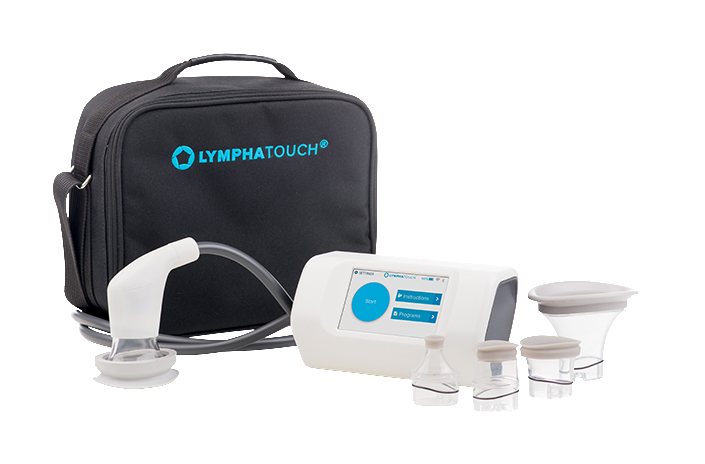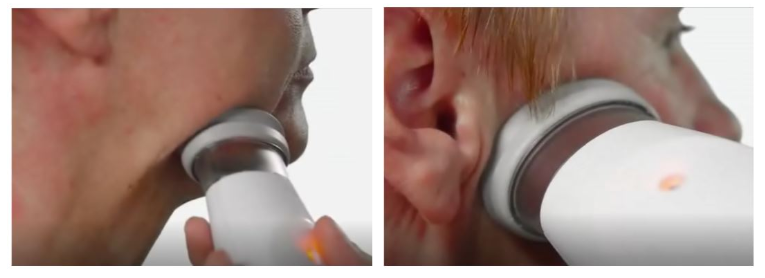Until recently, treatment options that support healing for patients that have had head and neck cancers have been limited. Because the symptoms of scaring, fibrosis, movement restriction and swelling can cause swallowing and breathing difficulties, finding treatments that will assist with healing these symptoms is critical. LymphaTouch® is a gentle tool that is able to assist in treating many of the symptoms that these patients endure. This device is truly unique because it creates negative pressure (suction) over tissues by stretching them vertically. Negative pressure treatments with LymphaTouch® assists therapist by giving different options that can significantly enhance their outcomes.

TREATMENT OPTIONS INCLUDE:
- Lymphoedema
- Fibrosis from radiation and lymphoedema
- Soft tissue restrictions; and
- Scar restrictions.
LYMPHOEDEMA:
Mimicking manual lymph drainage, LymphaTouch® generates negative pressure in the tissues while simultaneously opening the lymphatic capillaries. The device accomplishes this by lifting the skin and interstitial tissues in a pulsating rhythm. This combination creates an ideal environment for affective lymph drainage. Simply guide the treatment cup to follow the chosen lymphatic pathway, adjusting the amount of negative pressure needed for appropriate skin movement. When used over the neck, LymphaTouch® reaches deep swelling that restricts movement, breathing and swallowing.
FIBROSIS FROM RADIATION AND LYMPHOEDEMA
LymphaTouch offers different settings that help break up fibrosis.
With the rhythmic-pulsating setting, the device applies negative pressure to the hardened tissues, allowing for tissue stretch and expansion.
A slight setting adjustment allows negative pressure to be held continually, and tissues can be lifted and stretched for longer periods of time. Using the smaller treatment cups allows for vertical stretch behind the ear and on delicate places on the face.
The continual hold setting is similar to cupping, but, with the LymphaTouch®, we can control the amount of negative pressure for patient comfort (20-250mmHg) and we can stop the suction at any time. Cupping also creates negative pressure, but, when left on the skin, cups can create circular-shaped ecchymosis. Using LymphaTouch® instead can avoid this while protecting the already fragile tissues.
Mechanical high-frequency vibration is a feature that can be used with either the pulsating or continual hold setting. This vibration assists with breaking up radiation and lymphoedema fibrosis by shaking the area being treated. By adjusting the vibration’s Hertz, we are able to loosen deeper fibrotic areas that we normally would not be able to reach! This capability is especially useful around the waddle and larynx where areas of fibrosis are typically stubborn.
SOFT TISSUE RESTRICTIONS
Surgical scars and radiation on the head and neck can restrict movement, swallowing, speaking, and breathing. Using negative pressure on the continual hold setting, in conjunction with regular rehab practices, can significantly assist in relieving these symptoms.
Using the device over the temporomandibular joint (TMJ) can stretch the tissues in the joint to help ease movement. Myofascial tissue stretching can be enhanced by placing the device’s treatment cup over the inflexible areas on the face and neck. This technique can also be used over the larynx and hyoid, loosening any restriction around those areas that affect swallowing. LymphaTouch® can release restrictions in and around the diaphragm by reaching its deeper tissues.
Twisting or pulling the treatment cup horizontally can also increase the stretches’ effectiveness.
SCAR AND GRAFT-SITE RESTRICTIONS
REFERENCES
Gott, F. H., Ly, K., Piller, N., & Mangion, A. (2018). Negative pressure therapy in the management of lymphoedema. Journal of Lymphoedema, 13(1). http://lymphoedemaeducation.com.au/wp-content/uploads/2018/06/5.-Negative-pressure-therapy-in-the-management-of-lymphoedema.pdf
Iivarinen, J. T., Korhonen, R. K., & Jurvelin, J. S. (2016). Modeling of interstitial fluid movement in soft tissue under negative pressure–relevance to treatment of tissue swelling. Computer methods in biomechanics and biomedical engineering, 19(10), 1089-1098. https://www.tandfonline.com/doi/full/10.1080/10255842.2015.1101073?scroll=top&needAccess=true
Lacross, Z. T. (2014). Treatment outcomes of myofascial decompression on hamstring pathology (Doctoral dissertation, Oklahoma State University). https://shareok.org/handle/11244/14951

